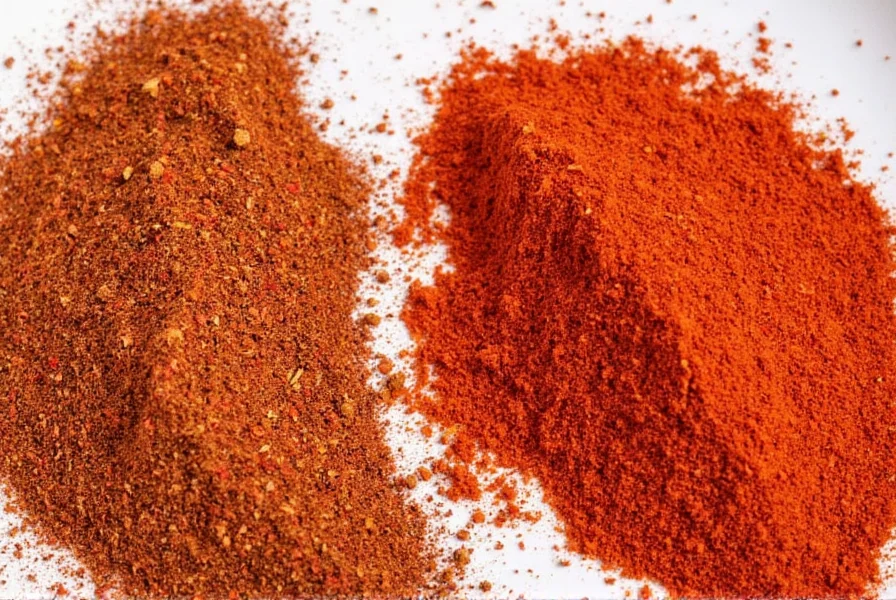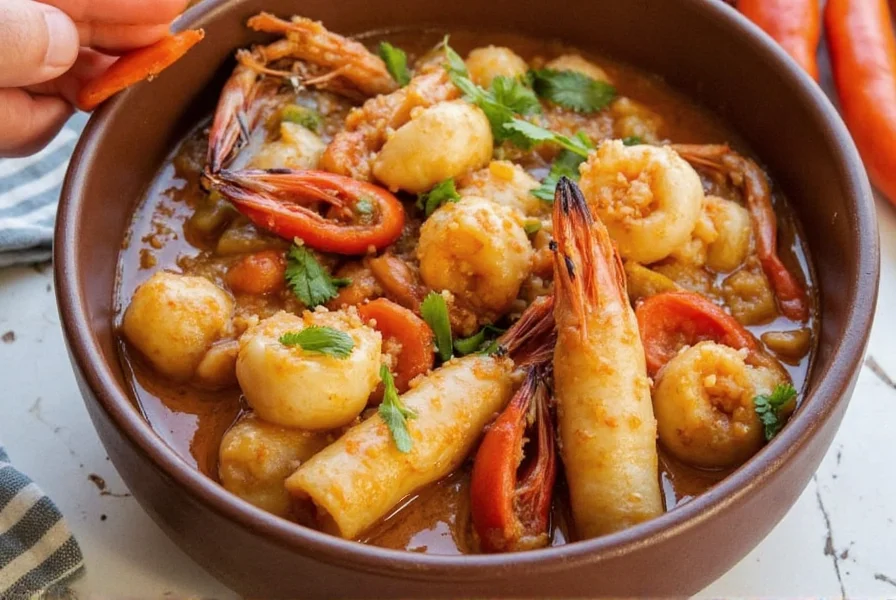Table of Contents
How to Make Perfect Fisherman's Seafood Stew
Discover how to create an authentic Fisherman's Seafood Stew with restaurant-quality flavor in under 30 minutes. This recipe focuses on perfect spice balance, seafood preparation techniques, and avoiding common mistakes like overcooking. You'll learn how to select fresh ingredients, manage heat levels, and achieve tender seafood every time.
Essential Spice Pairing Guide
Spices transform simple seafood into a complex, flavorful dish. Here's how to use them effectively:
| Spice | Heat Level (1-10) | Role in Seafood Stew |
|---|---|---|
| Cumin | 3 | Provides earthy base notes that complement oceanic flavors |
| Cayenne Pepper | 8 | Adds adjustable heat without overpowering delicate seafood |
| Paprika | 4 | Creates smoky depth and vibrant color |
| Garlic Powder | 2 | Enhances savory profile without raw garlic bitterness |
| Oregano | 5 | Brings herbal brightness that cuts through richness |
Pro Cooking Techniques for Seafood Stew
Follow these expert techniques for perfect results every time:
- Seafood Handling: Pat seafood dry before cooking to ensure proper searing. Add delicate items (shrimp, scallops) last to prevent toughness.
- Spice Toasting: Dry-toast whole cumin seeds for 1 minute before grinding to release maximum aroma.
- Heat Management: Start with 1/4 tsp cayenne, then adjust after adding tomatoes. Seafood absorbs heat quickly.
- Acidity Balance: Add 1 tbsp lemon juice at the end to brighten flavors without overpowering.
- Don't Overcook: Remove from heat when seafood is 90% cooked - residual heat finishes the cooking process.

Best Spices for Seafood Stew
Choose high-quality spices for optimal flavor:
Best Cumin for Seafood
Product Name: McCormick Gourmet Ground Cumin
Why it Works: Freshly ground with consistent particle size for even flavor distribution.
Pro Tip: Store in airtight container away from light to preserve volatile oils.
Best Cayenne for Seafood
Product Name: Spice Islands Cayenne Pepper
Why it Works: Made from pure red peppers without fillers, providing clean heat.
Pro Tip: Always measure with a spoon, not a pinch - cayenne intensity varies by brand.
Best Paprika for Seafood
Product Name: La Chinata Smoked Paprika
Why it Works: Traditional Spanish smoking process creates complex, woodsy notes.
Pro Tip: Use sweet smoked paprika for seafood - avoid hot varieties that overpower delicate fish.
Best Garlic Powder for Seafood
Product Name: Frontier Co-op Garlic Powder
Why it Works: Made from whole garlic cloves, not flakes, for authentic flavor.
Pro Tip: Mix with salt before adding to prevent clumping in oil.
Best Oregano for Seafood
Product Name: Simply Organic Mediterranean Oregano
Why it Works: Grown in Mediterranean climate for higher essential oil content.
Pro Tip: Add during last 2 minutes of cooking to preserve bright herbal notes.
Step-by-Step Fisherman's Seafood Stew Recipe
This recipe serves 4 and takes 25 minutes from start to finish. Follow these precise steps for perfect results:
Ingredients
- 1.5 lbs mixed seafood: 8 oz shrimp (peeled, deveined), 4 oz mussels (beards removed), 4 oz clams (scrubbed), 4 oz scallops
- 1 medium yellow onion (finely diced)
- 3 garlic cloves (minced)
- 1 cup fire-roasted diced tomatoes
- 2 tbsp extra virgin olive oil
- 1 tsp ground cumin
- 1 tsp smoked paprika
- 1/4 tsp cayenne pepper (adjust to taste)
- 1 tsp garlic powder
- 1 tsp dried oregano
- 2 cups seafood stock (homemade preferred)
- 1/4 cup dry white wine (optional)
- 1 tbsp fresh lemon juice
- Sea salt and black pepper to taste

Instructions
- Prepare seafood: Pat all seafood completely dry with paper towels. Keep mussels and clams in cold water until ready to use.
- Sear aromatics: Heat olive oil in heavy-bottomed pot over medium-high heat. Add onions and cook until translucent (3 mins). Add garlic and cook 1 minute until fragrant.
- Toast spices: Add cumin, paprika, cayenne, garlic powder, and oregano. Stir constantly for 45 seconds until spices release aroma (do not burn).
- Build broth: Pour in diced tomatoes and seafood stock. Bring to gentle simmer. Add wine if using.
- Cook shellfish: Add mussels and clams. Cover pot and cook 3-4 minutes until shells open. Discard any unopened shells.
- Add delicate seafood: Gently stir in shrimp and scallops. Cook uncovered 2-3 minutes until shrimp turn pink and scallops are opaque.
- Finish and serve: Remove from heat. Stir in lemon juice. Season with salt and pepper. Serve immediately with crusty bread.
Pro Tip: For perfect texture, cook seafood in batches if your pot is crowded. Overcrowding lowers temperature and causes steaming instead of searing.
Seafood Stew FAQs
How do I prevent overcooked seafood in my stew?
Seafood cooks extremely quickly. Always add shellfish first (mussels/clams), then wait until they open (3-4 minutes) before adding shrimp and scallops. Remove from heat when seafood is 90% cooked - residual heat will finish the process. Overcooking makes seafood rubbery and loses flavor. Use a timer: shrimp take 2-3 minutes, scallops 2-4 minutes depending on size.
Can I substitute fresh herbs for dried in this recipe?
Yes, but adjust quantities: use 3x the amount of fresh herbs versus dried. For oregano, add fresh leaves in the last 2 minutes of cooking. For garlic, use 3 cloves fresh instead of garlic powder. Fresh herbs provide brighter flavor but lose potency when cooked too long. Always add delicate fresh herbs at the end.
What's the best way to adjust spice heat levels?
Start with 1/4 tsp cayenne, then taste after adding tomatoes. Add heat in 1/8 tsp increments after the broth simmers. Remember: heat intensifies as stew reduces. For mild versions, replace cayenne with sweet paprika. For extra heat, add 1/4 tsp red pepper flakes with the spices. Never add cayenne directly to raw seafood - it causes bitterness.
Why does my seafood stew taste bland?
Blandness usually comes from insufficient seasoning or improper spice handling. Always toast spices before adding liquid - this unlocks flavor compounds. Add salt gradually: start with 1/2 tsp, then taste after simmering. If still bland, add 1 tsp fish sauce or 1 tbsp tomato paste for umami depth. Avoid over-diluting with too much stock - the broth should be rich and concentrated.
Can I make this stew ahead of time?
Yes, but with important caveats. Prepare the broth base (without seafood) up to 2 days ahead. Store in refrigerator. When ready to serve, reheat broth to simmer, then add fresh seafood and cook just until done. Never reheat cooked seafood - it becomes tough and rubbery. The broth base actually improves in flavor overnight as spices meld.
What wine pairs best with seafood stew?
Choose crisp, high-acid whites that cut through richness: Sauvignon Blanc (citrus notes), Pinot Grigio (light body), or Albariño (minerality). Avoid oaked wines like Chardonnay which clash with seafood. If not using wine in cooking, add 1 tbsp white wine vinegar to the broth for similar acidity. The wine should complement, not overpower, the delicate seafood flavors.










 浙公网安备
33010002000092号
浙公网安备
33010002000092号 浙B2-20120091-4
浙B2-20120091-4